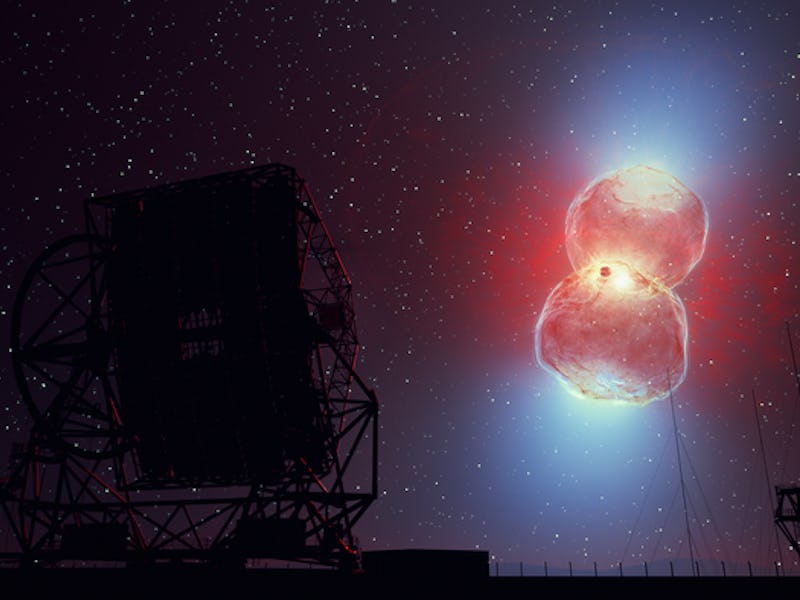A ravenous, explosive nova star may be creating massive gamma ray bursts
One star is stripped of material, which is then transferred to another star.

A star that had been in hiding for 15 years suddenly reappeared in the skies.
On August 9, 2021, the recurrent nova RS Ophiuchi had a dramatic outburst, brightening seven magnitudes over a period of 24 hours.
Alison Mitchell, a researcher at the Erlangen Centre for Astroparticle Physics in Germany, and other members of the High Energy Stereoscopic System (H.E.S.S.) Collaboration were waiting for this cosmic explosion.
“We have been trying to catch a nova for a long time,” Mitchell tells Inverse. “Typically the brightest novae are the most promising targets for us, and RS Ophiuchi was particularly bright — visible with the naked eye if you knew where to look.”
The reason why RS Ophiuchi is of interest is that the binary star system bursts out in repeated explosions, which could be a source of cosmic rays that bombard Earth from the Solar System.
Mitchell and colleagues detailed their findings in a study published Thursday in the journal Science.
HERE’S THE BACKGROUND — Picture two stars entangled in a binary system, one of which has exhausted all of its nuclear fuel.
The white dwarf star, which is the dense core left over after a star has run out of fuel, begins to suck away the gas from its stellar companion. This causes the binary star system to shine up to a million times brighter than its normal luminosity.
“In supernovae, the progenitor star is typically destroyed by the explosion, collapsing into a degenerate remnant,” Mitchell says. “But in novae, the star is not destroyed.”
Material ejected from the surface of the white dwarf generates shockwaves that rapidly expand, forming an hour-glass shape.
Over time, the amount of accumulated matter that the white dwarf star has drawn from its companion increases, and the surface of the star heats up. Nova outbursts occur when nuclear fusion is ignited on the surface of the white dwarf star, generating a thermonuclear explosion, or a rapid release of energy, that throws material outwards.
Recurrent novae are when a binary star system goes through repeated outbursts, increasing in brightness once every few decades. There are only 10 known recurrent novae where more than one outburst has been observed by astronomers.
RS Ophiuchi is one with a relatively small timeframe, with its last outburst having taken place in the year 2006.
WHAT’S NEW — Using observations from its most recent outburst, the team behind the new study found that these stellar explosions create an environment for protons to accelerate to very high energies.
“The thermonuclear explosion is so powerful that a shockwave is generated expanding outwards — particle acceleration takes place at the front of these shocks,” Mitchell says.
Scientists had long suspected that recurrent novae may be the source of galactic cosmic radiation, but the recent observations showed the mechanism by which these explosions can cause gamma ray emissions.
Gamma rays are a form of electromagnetic radiation produced by the hottest and most energetic objects in the universe. They have the smallest wavelengths and the most energy of any wave in the electromagnetic spectrum, making them difficult to detect. Because of this, the exact sources of gamma rays have remained a mystery.
The scientists behind the study monitored the emissions of RS Ophiuchi’s outburst for nearly a month and were able to track its evolution over time.
“With these observations, we were able to follow the evolution of particle energy in real-time,” Mitchell says.
The material ejected from the surface of the white dwarf star generates shockwaves that rapidly expand, forming an hourglass shape, according to the study. The particles of that material are then accelerated, colliding with the dense wind of the red giant star to produce very-high-energy gamma-ray photons.
The expanding shock wave from the RS Ophiuchi outburst accelerated protons to gigaelectron volt (one thousand million electron volts) and teraelectronvolt energies (the measure of kinetic energy produced by a single electron).
“As the shock plows through the surrounding environment, such as the dense wind of the larger companion star, the energetic protons at the shock front interact with the target material,” Mitchell says. “These interactions produce a variety of particles, including charged and neutral pions [subatomic particles], the neutral pions decay very rapidly into gamma-rays.”
The gamma rays help scientists trace the most energetic particles produced in the binary star system.
WHAT’S NEXT — The recent observations could help scientists gain insight into the source of galactic cosmic radiation which rains down on Earth.
Galactic cosmic radiation is a form of radiation that comes from the Sun, from within the Milky Way galaxy, as well as distant galaxies. It is produced by the interstellar medium, which is the gas and dust that lies between the stars.
When the radiation heads towards the direction of Earth, it interacts with the planet’s atmosphere to produce showers of secondary particles which can fall down on the planet’s surface.
Cosmic radiation is a risk factor to ongoing space missions and astronauts onboard spacecraft. In order to learn more about the source of cosmic radiation, scientists are hoping to observe recurrent novae in order to be able to trace the process by which gamma ray emissions are produced.